ELITEGROUP ECS G31T-M7 User Manual
Preface
Copyright
This publication, including all photographs, illustrations and software, is protected under international copyright laws, with all rights reserved. Neither this manual, nor any of the material contained herein, may be reproduced without written consent of the author.
Version 7.0
Disclaimer
The information in this document is subject to change without notice. The manufacturer makes no representations or warranties with respect to the contents hereof and specifically disclaims any implied warranties of merchantability or fitness for any particular purpose. The manufacturer reserves the right to revise this publication and to make changes from time to time in the content hereof without obligation of the manufacturer to notify any person of such revision or changes.
Trademark Recognition
Microsoft, MS-DOS and Windows are registered trademarks of Microsoft Corp.
MMX, Pentium, Pentium-II, Pentium-III, Celeron are registered trademarks of Intel Corporation.
Other product names used in this manual are the properties of their respective owners and are acknowledged.
Federal Communications Commission (FCC)
This equipment has been tested and found to comply with the limits for a Class B digital device, pursuant to Part 15 of the FCC Rules. These limits are designed to provide reasonable protection against harmful interference in a residential installation. This equipment generates, uses, and can radiate radio frequency energy and, if not installed and used in accordance with the instructions, may cause harmful interference to radio communications. However, there is no guarantee that interference will not occur in a particular installation. If this equipment does cause harmful interference to radio or television reception, which can be determined by turning the equipment off and on, the user is encouraged to try to correct the interference by one or more of the following measures:
•Reorient or relocate the receiving antenna
•Increase the separation between the equipment and the receiver
•Connect the equipment onto an outlet on a circuit different from that to which the receiver is connected
•Consult the dealer or an experienced radio/TV technician for help
Shielded interconnect cables and a shielded AC power cable must be employed with this equipment to ensure compliance with the pertinent RF emission limits governing this device. Changes or modifications not expressly approved by the system’s manufacturer could void the user’s authority to operate the equipment.
Preface
ii
Declaration of Conformity
This device complies with part 15 of the FCC rules. Operation is subject to the following conditions:
•This device may not cause harmful interference, and
•This device must accept any interference received, including interference that may cause undesired operation
Canadian Department of Communications
This class B digital apparatus meets all requirements of the Canadian Interferencecausing Equipment Regulations.
Cet appareil numérique de la classe B respecte toutes les exigences du Réglement sur le matériel brouilieur du Canada.
About the Manual
The manual consists of the following:
Chapter 1
Introducing the Motherboard
Chapter 2
Installing the Motherboard
Chapter 3
Using BIOS
Describes features of the motherboard.
Go to H page 1
Describes installation of motherboard components.
Go to H page 7
Provides information on using the BIOS Setup Utility.
Go to |
H page 25 |
Chapter 4 |
Describes the motherboard soft- |
||
Using the Motherboard Software |
ware |
|
|
Go to |
H page 43 |
||
|
|||
Chatper 5 |
Provides basic troubleshooting |
||
Trouble Shooting |
tips |
|
|
Go to |
H page 47 |
||
|
|||
Preface

iii
TABLE OF CONTENTS |
|
Preface |
i |
Chapter 1 |
1 |
Introducing the Motherboard |
1 |
Introduction...................................................................................... |
1 |
Feature............................................................................................... |
2 |
Motherboard Components............................................................. |
4 |
Chapter 2 |
7 |
Installing the Motherboard |
7 |
Safety Precautions........................................................................... |
7 |
Choosing a Computer Case............................................................ |
7 |
Installing the Motherboard in a Case............................................ |
7 |
Checking Jumper Settings............................................................... |
8 |
Setting Jumpers................................................................... |
8 |
Checking Jumper Settings................................................... |
9 |
Jumper Settings................................................................... |
9 |
Installing Hardware........................................................................ |
10 |
Installing the Processor..................................................... |
10 |
Installing Memory Modules............................................... |
12 |
Expansion Slots.................................................................. |
14 |
Connecting Optional Devices............................................. |
16 |
Installing a Hard Disk Drive/CD-ROM/SATA Hard Drive... |
18 |
Installing a Floppy Diskette Drive.................................... |
19 |
Connecting I/O Devices................................................................. |
20 |
Connecting Case Components...................................................... |
21 |
Front Panel Header............................................................ |
23 |
Chapter 3 |
25 |
Using BIOS |
25 |
About the Setup Utility................................................................. |
25 |
The Standard Configuration.............................................. |
25 |
Entering the Setup Utility.................................................... |
25 |
Resetting the Default CMOS Values.................................. |
26 |
Using BIOS...................................................................................... |
27 |
Standard CMOS Setup...................................................... |
28 |
Advanced Setup................................................................. |
30 |
Advanced Chipset Setup.................................................... |
33 |
i v
Integrated Peripherals....................................................... |
34 |
Power Management Setup................................................. |
35 |
PCI/PnP Setup................................................................... |
37 |
PC Health Status............................................................... |
37 |
Frequency/Voltage Control................................................ |
40 |
Load Default Settings........................................................ |
41 |
Supervisor Password........................................................ |
41 |
User Password.................................................................. |
41 |
Save & Exit Setup.............................................................. |
42 |
Exit Without Saving............................................................ |
42 |
Updating the BIOS............................................................. |
42 |
Chapter 4 |
43 |
Using the Motherboard Software |
43 |
About the Software DVD-ROM/CD-ROM................................. |
43 |
Auto-installing under Windows XP/Vista/7............................... |
43 |
Running Setup.................................................................... |
44 |
Manual Installation........................................................................ |
46 |
Utility Software Reference............................................................ |
46 |
Chapter 5 |
47 |
Trouble Shooting |
47 |
Start up problems during assembly....................................................... |
47 |
Start up problems after prolong use................................................. |
48 |
Maintenance and care tips.................................................................. |
48 |
Basic Troubleshooting Flowchart................................................... |
49 |

1
Chapter 1
Introducing the Motherboard
Introduction
Thank you for choosing the G31T-M7 motherboard. This motherboard is a high performance, enhanced function motherboard designed to support the LGA775 socket
Intel® Yorkfield/Wolfdale/Core™ 2 Quad (Q6600/Q6700 G0)/Pentium® Dual-Core/ Celeron® 4xx Series processors for high-end business or personal desktop markets.
The motherboard incorporates the G31 Northbridge (NB) and ICH7 Southbridge (SB) chipsets. The Northbridge supports a Front Side Bus (FSB) frequency of 1333/ 1066/800 MHz using a scalable FSB Vcc_CPU. The memory controller supports DDR2 memory DIMM frequencies of 800/667. It supports two DDR2 sockets with up to maximum memory of 4 GB. DDR2 Maximum memory bandwidth of 12.8 GB/ s in dual-channel symmetric mode assuming DDR2 800 MHz. High resolution graphics via one PCI Express slot, intended for Graphics Interface, is fully compliant to the PCI Express Base Specification revision 1.1.
The ICH7 Southbridge supports two PCI slots which are PCI 2.3 compliant. In addition, one PCI Express x1 slot is supported, fully compliant to the PCI Express Base Specification revision 1.1. It implements an EHCI compliant interface that provides 480 Mb/s bandwidth for eight USB 2.0 ports (four USB ports and two USB 2.0 headers support additional four USB ports). One onboard IDE connector supports two IDE devices in Ultra ATA100/66/33 mode. The Southbridge integrates a Serial ATA host controller, supporting four SATA ports with maximum transfer rate up to 3.0 Gb/s each.
The motherboard is equipped with advanced full set of I/O ports in the rear panel, including PS/2 mouse and keyboard connectors, COM, VGA port, LPT, four USB ports, one LAN port, and audio jacks for microphone, line-in and line-out.
Introducing the Motherboard

2
Feature
Processor
The motherboard uses an LGA775 type of Intel® Yorkfield/Wolfdale/Core™ 2
Quad (Q6600/Q6700 G0)/Pentium® Dual-Core/Celeron® 4xx Series that carries the following features:
•Accommodates Intel® Yorkfield/Wolfdale/Core™ 2 Quad (Q6600/Q6700
G0)/Pentium® Dual-Core/Celeron® 4xx Series processors
•Supports a system bus (FSB) of 1333/1066/800 MHz
•Supports “Hyper-Threading” technology CPU
“Hyper-Threading” technology enables the operating system into thinking it’s hooked up to two processors, allowing two threads to be run in parallel, both on separate “logical” processors within the same physical processor.
Chipset
The G31 Northbridge (NB) and ICH7 Southbridge (SB) chipsets are based on an innovative and scalable architecture with proven reliability and performance.
G31 (NB) |
• |
Supports 36-bit host bus addressing, allowing the CPU |
|
|
to access the entire 64 GB of the memory address |
|
|
space |
|
• |
2 GB/s point-to-point Direct Media Interface (DMI) to |
|
|
ICH7 (1 GB/s each direction) |
|
• |
Supports 512 Mb and 1 Gb DDR2 DRAM technologies |
|
|
for x8 and x16 devices |
|
• |
One, 16-lane PCI Express port intended for Graphics |
|
|
Attach, compatible to the PCI Express* Base Specifi- |
|
|
cation revision 1.1 |
ICH7 (SB) |
• |
Enhanced DMA Controller, interrupt controller, and timer |
|
|
functions |
|
• |
Compliant with PCI Express Base Specification, Revi- |
|
|
sion 1.1 |
|
• |
Compliant with PCI 2.3 specification |
|
• |
Integrated SATA 3.0 Gb/s Host Controller |
|
• |
Integrated USB 2.0 Host Controller supporting up to |
|
|
eight USB 2.0 ports |
Memory |
• |
Integrated IDE controller supports Ultra ATA 100/66/33 |
|
|
•Supports DDR2 800/667 DDR SDRAM with Dual-channel architecture
•Accommodates two unbuffered DIMMs
•Up to 2 GB per DIMM with maximum memory size up to 4 GB
Onboard LAN (optional)
The onboard LAN controller provides either of the following features:
•Supports 10/100 Mbps Ethernet Transceiver
•Fully compliant with IEEE802.3, IEEE802.3u, IEEE802.3ab
•Wake-On-LAN(WOL) by Magic Packet/Frame/Link Change
•Integrated PHY for 10/100/1000 Mbps
•IEEE 802.3x compliant flow control support
•Three power supplies: 2.5V, 1.8V and 1.2V
•PCI Express base 1.1 compliant
Introducing the Motherboard

3
Audio (optional)
This motherboard may support either of the following Audio chipsets:
•5.1 Channel High Definition Audio Codec
•ADCs support 44.1K/48K/96KHz sample rate
•Meet Microsoft WLP 3.08 Vista premium and mobile PCs audio requirements
•Direct Sound 3DTM compatible
•5.1 Channel High Definition Audio Codec
•Exceeds Microsoft Windows Logo Program (WLP) Requirements
•ADCs support 44.1K/48K/96K/192KHz sample rate
•Power Support: Digital: 3.3V; Analog: 5.0V
Expansion Options
The motherboard comes with the following expansion options:
•One PCI Express slot for Graphic Interface
•One PCI Express x1 Slot
•Two 32-bit PCI v2.3 compliant slots
•One IDE connector that supports two IDE devices
•One floppy disk drive interface
•Four 7-pin SATA connectors
Integrated I/O
The motherboard has a full set of I/O ports and connectors:
•Two PS/2 ports for mouse and keyboard
•One serial port
•One parallel port
•One VGA port
•Four USB ports
•One LAN port
•Audio jacks for microphone, line-in and line-out
BIOS Firmware
This motherboard uses AMI BIOS that enables users to configure many system features including the following:
•Power management
•Wake-up alarms
•CPU parameters
•CPU and memory timing
The firmware can also be used to set parameters for different processor clock speeds.
1.Some hardware specifications and software items are subject to change without prior notice.
2.Due to chipset limitation, we recommend that motherboard be operated in the ambiance between 0 and 50° C.
Introducing the Motherboard
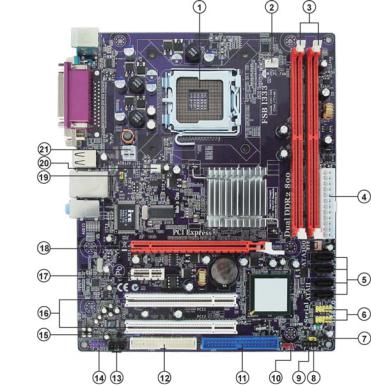
4
Motherboard Components
Introducing the Motherboard

5
Table of Motherboard Components
|
|
LABEL |
COMPONENTS |
|
|
|
LGA775 socket for Intel® Yorkfield/Wolfdale/Core™ 2 |
1. |
CPU Socket |
Quad (Q6600/Q6700 G0)/Pentium® Dual-Core/ |
|
|
|
|
Celeron® 4xx Series processors |
2. |
CPU_FAN |
CPU cooling fan connector |
|
3. DDR2_1~2 |
240-pin DDR2 SDRAM slots |
||
4. ATX_POWER |
Standard 24-pin ATX power connector |
||
5. |
SATA1~4 |
Serial ATA connectors |
|
6. |
F_USB1~2 |
Front Panel USB headers |
|
7. |
SPK |
Speaker header |
|
8. |
USBPWR_F |
Front Panel USB Power Select Jumper |
|
9. |
F_PANEL |
Front panel switch/LED header |
|
10. CLR_CMOS |
Clear CMOS jumper |
||
11. |
IDE |
Primary IDE channel |
|
12. |
FDD |
Floppy disk drive connector |
|
13. |
CD_IN |
Analog audio input connector |
|
14. |
F_AUDIO |
Front panel audio header |
|
15. |
SPDIFO |
SPDIF out header |
|
16. |
PCI1~2 |
32-bit add-on card slots |
|
17. |
PCIE |
PCI Express x1 slot |
|
18. |
PCIEX16 |
PCI Express x16 graphics card slot |
|
19. |
USBPWR_R |
Rear Panel USB PS/2 Power Select Jumper |
|
20. |
SYS_FAN |
System cooling fan connector |
|
21. |
ATX12V |
4-pin +12V power connector |
|
This concludes Chapter 1. The next chapter explains how to install the motherboard.
Introducing the Motherboard
6
Memo
Introducing the Motherboard

7
Chapter 2
Installing the Motherboard
Safety Precautions
•Follow these safety precautions when installing the motherboard
•Wear a grounding strap attached to a grounded device to avoid damage from static electricity
•Discharge static electricity by touching the metal case of a safely grounded object before working on the motherboard
•Leave components in the static-proof bags they came in
•Hold all circuit boards by the edges. Do not bend circuit boards
Choosing a Computer Case
There are many types of computer cases on the market. The motherboard complies with the specifications for the Micro ATX system case. First, some features on the motherboard are implemented by cabling connectors on the motherboard to indicators and switches on the system case. Make sure that your case supports all the features required. Secondly, this motherboard supports one floppy diskette drive and two enhanced IDE drives. Make sure that your case has sufficient power and space for all drives that you intend to install.
Most cases have a choice of I/O templates in the rear panel. Make sure that the I/O template in the case matches the I/O ports installed on the rear edge of the motherboard.
This motherboard carries a Micro ATX form factor of 244 x 200 mm. Choose a case that accommodates this form factor.
Installing the Motherboard in a Case
Refer to the following illustration and instructions for installing the motherboard in a case.
Most system cases have mounting brackets installed in the case, which correspond the holes in the motherboard. Place the motherboard over the mounting brackets and secure the motherboard onto the mounting brackets with screws.
Ensure that your case has an I/O template that supports the I/O ports and expansion slots on your motherboard.
Installing the Motherboard
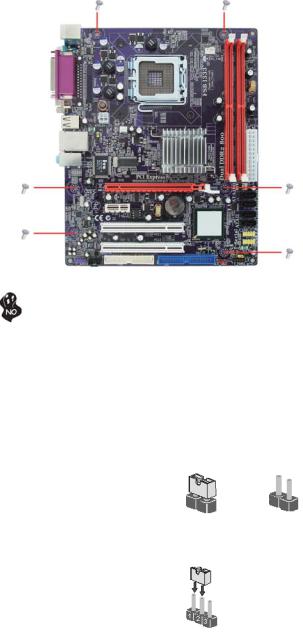
8
Do not over-tighten the screws as this can stress the motherboard.
Checking Jumper Settings
This section explains how to set jumpers for correct configuration of the motherboard.
Setting Jumpers
Use the motherboard jumpers to set system configuration options. Jumpers with more than one pin are numbered. When setting the jumpers, ensure that the jumper caps are placed on the correct pins.
The illustrations show a 2-pin jumper. |
|
|
When the jumper cap is placed on both |
|
|
pins, the jumper is SHORT. If you re- |
|
|
move the jumper cap, or place the jumper |
|
|
cap on just one pin, the jumper is OPEN. |
SHORT |
OPEN |
|
This illustration shows a 3-pin jumper.
Pins 1 and 2 are SHORT.
Installing the Motherboard
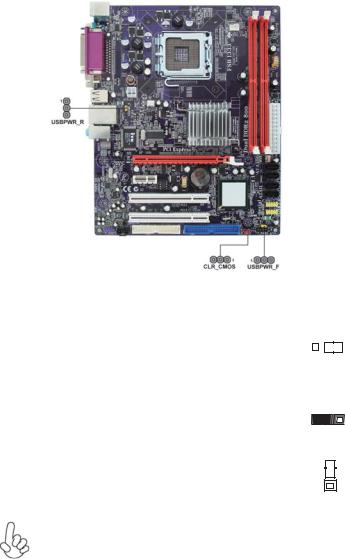
9
Checking Jumper Settings
The following illustration shows the location of the motherboard jumpers. Pin 1 is labeled.
Jumper Settings
Jumper |
Type |
Description |
Setting (default) |
|
|
|
|
|
|
|
|
|
|
|
|
|
|
|
|
|
1-2: NORMAL |
|
|
|
|
|
CLR_CMOS |
3-pin |
Clear CMOS |
2-3: CLEAR CMOS |
|
|
|
|
1 |
|
|
|
|
|||||
|
|
|
|
|
|
|||
CMOS, make sure to |
CLR_CMOS |
|||||||
|
|
|
Before clearing the |
|
|
|
|
|
|
|
|
turn off the system. |
|
|
|
|
|
|
|
|
|
|
|
|
|
|
USBPWR_F |
3-pin |
Front Panel |
1-2: VCC |
1 |
|
|
|
|
USB Power |
|
|
|
|
||||
2-3: 5VSB |
|
|
|
|
||||
|
|
Select Jumper |
USBPWR_F |
|||||
|
|
|
||||||
|
|
|
|
|
|
|
|
|
USBPWR_R |
3-pin |
Rear USB PS/2 |
1-2: VCC |
1 |
|
|
|
|
|
|
|
||||||
|
|
|
||||||
Power Select |
|
|
|
|
|
|||
|
|
2-3: 5VSB |
|
|
|
|
|
|
|
|
Jumper |
|
|
|
|
|
|
|
|
USBPWR_R |
||||||
|
|
|
|
|||||
1.To avoid the system instability after clearing CMOS, we recommend users to enter the main BIOS setting page to “Load Optimal Defaults” and then “Save Changes and Exit”.
2.Make sure the power supply provides enough 5VSB voltage before selecting the 5VSB function.
3.It is required that users place the USBPWR_F & USBPWR_R cap onto 2-3 pin rather than 1-2 pin as default if you want to wake up the com-
puter by USB/PS2 KB/Mouse.
Installing the Motherboard

10
Installing Hardware
Installing the Processor
Caution: When installing a CPU heatsink and cooling fan make sure that you DO NOT scratch the motherboard or any of the surfacemount resistors with the clip of the cooling fan. If the clip of the cooling fan scrapes across the motherboard, you may cause serious damage to the motherboard or its components.
On most motherboards, there are small surface-mount resistors near the processor socket, which may be damaged if the cooling fan is carelessly installed.
Avoid using cooling fans with sharp edges on the fan casing and the clips. Also, install the cooling fan in a well-lit work area so that you can clearly see the motherboard and processor socket.
Before installing the Processor
This motherboard automatically determines the CPU clock frequency and system bus frequency for the processor. You may be able to change the settings in the system Setup Utility. We strongly recommend that you do not over-clock processors or other components to run faster than their rated speed.
Warning:
1.Over-clocking components can adversely affect the reliability of the system and introduce errors into your system. Over-clocking can permanently damage the motherboard by generating excess heat in components that are run beyond the rated limits.
2.Always remove the AC power by unplugging the power cord from the power outlet before installing or removing the motherboard or other hardware components.
This motherboard has an LGA775 socket. When choosing a processor, consider the performance requirements of the system. Performance is based on the processor design, the clock speed and system bus frequency of the processor, and the quantity of internal cache memory and external cache memory.
Installing the Motherboard
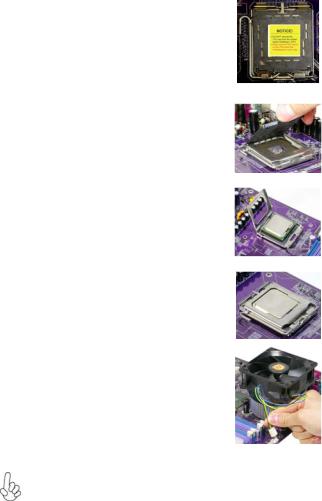
11
CPU Installation Procedure
The following illustration shows CPU installation components.
A.Read and follow the instructions shown on the sticker on the CPU cap.
B.Unload the cap
·Use thumb & forefinger to hold the lifting tab of the cap.
·Lift the cap up and remove the cap completely from the socket.
C.Open the load plate
·Use thumb & forefinger to hold the hook of the lever, pushing down and pulling aside unlock it.
·Lift up the lever.
·Use thumb to open the load plate. Be careful not to touch the contacts.
D.Install the CPU on the socket
·Orientate CPU package to the socket.
Make sure you match triangle marker to pin 1 location.
E.Close the load plate
·Slightly push down the load plate onto the tongue side, and hook the lever.
·CPU is locked completely.
F.Apply thermal grease on top of the CPU.
G.Fasten the cooling fan supporting base onto the CPU socket on the motherboard.
H.Make sure the CPU fan is plugged to the
CPU fan connector. Please refer to the
CPU cooling fan user’s manual for more detail installation procedure.
1. To achieve better airflow rates and heat dissipation, we suggest that you use a high quality fan with 3800 rpm at least. CPU fan and heatsink installation procedures may vary with the type of CPU fan/ heatsink supplied. The form and size of fan/heatsink may also vary.
2. DO NOT remove the CPU cap from the socket before installing a CPU.
3. Return Material Authorization (RMA) requests will be accepted only if the motherboard comes with the cap on the LGA775 socket.
Installing the Motherboard
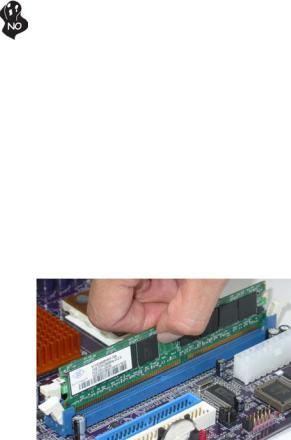
12
Installing Memory Modules
This motherboard accommodates two memory modules. It can support two 240-pin DDR2 800/667. The total memory capacity is 4 GB.
DDR2 SDRAM memory module table
Memory module |
Memory Bus |
DDR2 667 |
333 MHz |
DDR2 800 |
400 MHz |
You must install at least one module in any of the two slots. Each module can be installed with 2 GB of memory; total memory capacity is 4 GB.
Do not remove any memory module from its antistatic packaging until you are ready to install it on the motherboard. Handle the modules only by their edges. Do not touch the components or metal parts. Always wear a grounding strap when you handle the modules.
Installation Procedure
Refer to the following to install the memory modules.
1This motherboard supports unbuffered DDR2 SDRAM .
2Push the latches on each side of the DIMM slot down.
3Align the memory module with the slot. The DIMM slots are keyed with notches and the DIMMs are keyed with cutouts so that they can only be installed correctly.
4Check that the cutouts on the DIMM module edge connector match the notches in the DIMM slot.
5Install the DIMM module into the slot and press it firmly down until it seats correctly. The slot latches are levered upwards and latch on to the edges of the DIMM.
6Install any remaining DIMM modules.
Installing the Motherboard
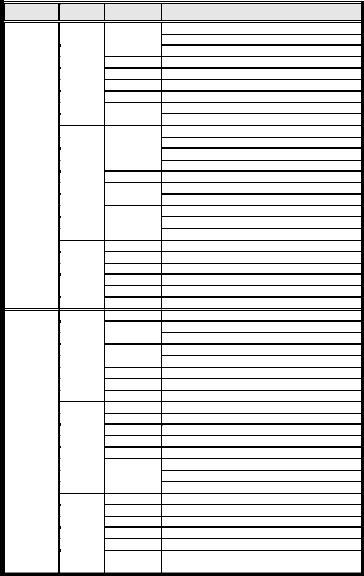
13
Table A: DDR2 (memory module) QVL (Qualified Vendor List)
The following DDR2 800/667 memory modules have been tested and qualified for use with this motherboard.
Type |
Size |
Vendor |
Module Name |
|
|
Corsair |
VALUESELECT 32M8CEC |
|
|
64M8CFE PS1000545 |
|
|
|
|
Corsair K4T51083QC |
|
|
GEIL |
GL2L64M088BA18W |
|
512 MB |
Ramaxel |
5LB31 D9DCL |
|
|
SAMSUNG |
K4T 51083QC |
|
|
SyncMAX |
E5108AB-5C- E |
|
|
T ranscend |
SEL520Z CE6 K4T51083QC |
|
|
JetRam J12Q3AB-6 |
|
|
|
|
|
|
|
|
Elpida 1GB AM4B5708GEWS7E-0637F |
|
|
APACER |
AM4B5708GQJS7E0631F |
|
|
78.91G92.9K5 |
|
DDR2 667 |
|
|
|
|
|
78.01G9O .9K5 |
|
|
1 GB |
APOGEE |
AU51082667P005 |
|
Micron |
MT4HT F6464AY-667E1 |
|
|
|
||
|
|
MT8HT F12864AY-667E1 |
|
|
|
|
|
|
|
PSC |
AL7E8E63B-6E1T |
|
|
AL7E8F 73C -6E1 |
|
|
|
|
AL6E8E63J-6E1 |
|
|
Aeneon |
AET 860UD00-30DB08X |
|
|
Apacer |
78.A1G9O.9K4 |
|
2 GB |
Hynix |
HYMP125U64AP8-Y5-AB-A |
|
LeadMax |
LeadMax LD5PS1G831 |
|
|
|
||
|
|
PSC |
AL8E8F 73C -6E1 |
|
|
Qimonda |
HYS64T256020EU-3S-C2 |
|
|
CORSAIR |
CM2X1024-6400PRO |
|
|
Infinity |
04751208CZ 5U 2D |
|
|
04701G16CZ5U2G |
|
|
|
|
|
|
512 MB |
Kingston |
KHX6400D2ULK2/1G |
|
KVR800D 2N 5/512 |
||
|
|
|
|
|
|
Micron |
MT8HTF 6464AY-80ED4 |
|
|
SyncMAX |
U538H8G090HL |
|
|
UMAX |
U2S12D30T P-8E |
|
|
Aeneon |
AET 760U D00-25DC08X |
|
|
APACER |
78.01GA0.9K5 |
|
|
Infinity |
04701G16CZ5U2G |
DDR2 800 |
1 GB |
Kingston |
KVR800D2N5/1G |
|
NPC |
NCPT7AUDR-25M48 |
|
|
|
||
|
|
|
IMEAER422LA0112 |
|
|
PQI |
MEAER421LA011008A6 |
|
|
|
MEAER422LB0107 |
|
|
Aeneon |
AET 860U D00-25DC08X |
|
|
Apacer |
78.A1GA0.9K4 |
|
|
Micron |
MT 16H TF25664AY-800E1 |
|
2 GB |
PSC |
AL8E8F73C-8E1 |
|
|
Qimonda |
HYS64T256020EU25F -C2 |
|
|
Silicon |
SP002GBLRU800S01 |
|
|
Power |
|
|
|
|
Installing the Motherboard
